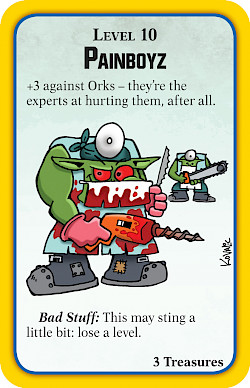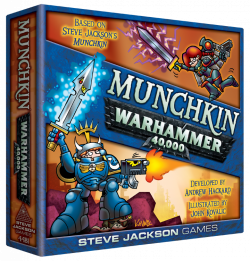Design Diary: 1,000 Words (Give or Take) About Working With John Kovalic on Munchkin Warhammer 40,000
Andrew Hackard
December 19, 2018
They say a picture is worth 1,000 words, and I was very tempted to ask John to draw something that he felt symbolized our working relationship and call it a day. However, John's a busy man (as I write this, he's finishing up the artwork for Munchkin Warhammer 40,000: Savagery and Sorcery and working on a couple of smaller projects we can't talk about yet) and so it falls to me to babble for a while.
John and I have known each other a long time. We first formally met at Gen Con 2000, in Milwaukee, but by then I'd been reading Dork Tower for over a year and had seen his work on Chez Geek and other games. Over the next several years, we worked on the same projects a couple of times and saw each other fairly often. One of the things I most looked forward to when I started as Munchkin Line Editor in January, 2009, was working more closely with John. Little did either of us know how closely that would be over the next decade!
How a Silly Idea Becomes an Equally Silly Drawing
 On Munchkin Warhammer 40,000, as with most of our projects, I started out by looking at the source material and making some general notes about what might go into the game. I consulted John especially early on this project because, as we may have mentioned, John is a bit of a Warhammer 40,000 fanboy. (All those "Warhamster" jokes in Dork Tower should have been a clue . . .) Once I had the general skeleton of the game, I started going through the Warhammer 40,000 8th edition books looking for ideas that met some or, ideally, all of a few criteria:
On Munchkin Warhammer 40,000, as with most of our projects, I started out by looking at the source material and making some general notes about what might go into the game. I consulted John especially early on this project because, as we may have mentioned, John is a bit of a Warhammer 40,000 fanboy. (All those "Warhamster" jokes in Dork Tower should have been a clue . . .) Once I had the general skeleton of the game, I started going through the Warhammer 40,000 8th edition books looking for ideas that met some or, ideally, all of a few criteria:
- It had to be either from the Warhammer 40,000 game or a clear parody of something from the game. This includes the players – we couldn't have done cards like Left Your Terrain at Home otherwise.
- It had to have enough of a distinctive look that John could do something with it on the art side.
- It was either inherently funny (holla to my Painboyz!) or something we could make funny with the right text and/or art.
Once I have the list of cards, I have to write a brief art specification ("spec") for each one. This is usually a sentence or two describing the illustration for each card. Where we have reference material – and we had a lot of it on this project! – I'll give one or two references that I think offer the best inspiration for John to work from. Games Workshop was kind enough to send SJ Games and John a complete library of Warhammer 40,000 8th Edition Codices, in both PDF and hardcopy, and we both made extensive use of this fantastic resource. Thanks to our pals across the ocean!
Because John and Steve and I have worked closely together, sometimes I'm able to give John an abbreviated spec – even just, "John, give us something good here." With John's extensive Warhammer 40,000 knowledge, I may have leaned on this more heavily than I would have otherwise. It's great to know you're working with an artist that gets it! Fortunately, John's not afraid to ask questions (many of which begin "What the . . .") when he doesn't understand what I'm asking for, and we've hopped on the phone a few times to talk over something rather than try to bash it out over email.
 A Sketchy Procedure
A Sketchy Procedure
Generally, our artists start with a sketch before proceeding to finished inks. In the old days, this would have been a true pencil sketch, and some artists still work that way. As digital art becomes more common, however, we're starting to see more artists send in "sketches" that look like finished if somewhat simple art. Most of John's sketches look like this, and it makes it easy to approve or to suggest changes before the final submission (called the "inks," which these days can easily mean a cleaned-up digital image rather than something actually inked).
A wrinkle on this project in particular was that John moved a lot of his "inking" over to the iPad, which meant he had a learning curve but could work on art just about anywhere, instead of being tied to his drawing table most of the time. I don't know if it had a huge effect on the resulting art itself, but it seemed to ease some deadline pressure when John was traveling or the weather conspired to keep him at home. Certainly, both SJ Games and Games Workshop couldn't be more pleased with John's work on this project!
After John's illustrations are submitted and approved – and with a licensed game such as Munchkin Warhammer 40,000, that approval step is crucial – they go to our production team for coloring and layout. Sabrina Gonzalez heads up that team, which includes Alex Fernandez, Gabby Ruenes, and Ben Williams. Meanwhile, John didn't get much of a chance to rest, because while all of this was going on, I was writing cards for the expansions and sending those cards and specs over to John so he could keep right on drawing. Between Munchkin Warhammer 40,000, Faith and Firepower, and Savagery and Sorcery, I wrote and John drew almost 400 total cards. John, thanks for putting your drawing arm through the wringer once again!

